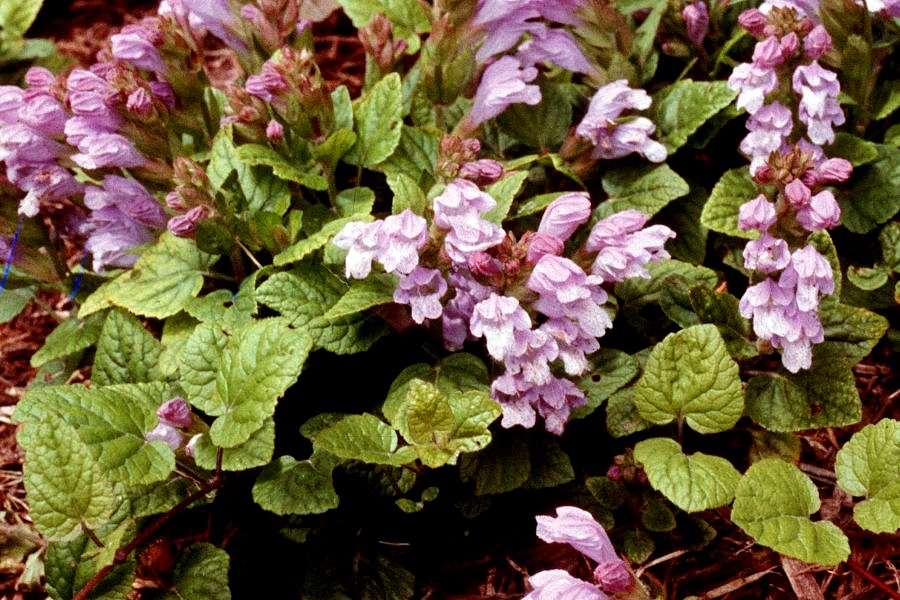When botanist Thomas Meehan died in 1901, I'm sure he went to the big forest in the sky feeling proud that Nathaniel Lord Britton had named a genus of plants in his honor. I'd also bet that he didn't know how wonderful his namesake plant was. In fact, most people don't know how wonderful Meehania cordata is.
Charles and Martha Oliver are proprietors of the Primrose Path Nursery in Scottdale, Pa., and dear friends of mine. I'd noticed Meehania cordata listed in their catalog, and after reading their description and hearing them extol the virtues about how charming this little plant was, I asked them to please bring me one on their upcoming visit. I had requested one the year before, but it always seemed they were sold out, so I was emphatic that I must have one, and intimated should they not bring me one, they may end up sleeping in my barn that chilly autumn night.
Tiarella, Heuchera, and Heucherella are the main focus of their breeding work, so we had planned a day of Tiarella hunting in Wolfpen Hollow, a hauntingly mysterious woodland area near my farm. We'd just descended a summit into the foggy creek bottom when I heard Charles laughing hysterically behind me on the trail. I turned to see what he found so amusing and saw him pointing to the ground. There, all around him, the ground was covered with Meehan's Mint.
Talk about getting caught not practicing what you preach. Me, who in all of my lectures on native plants makes a point of telling people to look in their own backyards! After I recovered from my initial embarrassment, we looked further and found the entire west-facing slope of the hill down to the creekbed was a veritable carpet of dark, almost glossy green cordate (heart-shaped, hence the specific epithet "cordata") leaves, vining over rocks and decaying tree limbs basking in the deep shade of hemlock and oak woods above the water.
I took some cuttings, not knowing whether they would root so late in the season, but I had a gut feeling of optimism. Sure enough, they rooted in a matter of weeks.
The following spring, I checked in on the population and found that the new growth was thick and lovely. In June, I went back to observe the flowers and found a sea of lilac, pink, and lavender trumpet-like blooms at the tips of the stems. They reminded me very much of Scuttellaria, another member of the mint family and close relative of Meehania.
In my garden, now having many plants from the rooted cuttings that I overwintered under a dark bench in a polytunnel (another testament to the virtues of Meehania is how deep a shade it thrives in), I proceeded to plant them under a small grove of lilacs and viburnums. They responded to the rich humus that had accumulated under these older shrubs and almost immediately started to wind their way around on the ground.
Taxonomically speaking, Meehania cordata is a member of the Lamiaceae (mint) family. In North America, it is a monotypic (single) specie in the genus. Its reported range is from southwest Pennsylvania to North Carolina and Tennessee. Its heart-shaped leaves are on the small side, averaging one-inch long to one-and-a-half inches wide at the petiole. I suspect it is hardy to zone four and maybe even three.
I know of at least one other Meehania species in cultivation, that being Meehania urticifolia, cordata's Asian cousin. It can be found growing in mountain forests in the Honshu area of Japan. The specific epithet urticifolia refers to the nettle-like foliage. It is also very easy to propagate from stem cuttings and by division.
Meehania cordata is one of the best plants I can think of for those dark and foreboding corners of the garden where there isn't enough light for most other plants. Even if it didn't have the added benefit of those really bright colorful flowers, I would recommend it as a very useful groundcover.
Native garden plant may go unnoticed in the wild

A picture speaks a thousand words, and that’s a good thing because I have a lot to say about this plant that could best be said in pictures. And I’d be happy to hear that this article stimulated you enough to go out hunting for Hydrophyllum virginianum in the wild this spring. READ THE FULL STORY HERE.
Barry Glick, a transplanted Philadelphian, has resided in Greenbrier County, West Virginia, since 1972. His mountaintop garden and nursery attract gardeners from every country in the world. Barry writes and lectures extensively about native plants and Hellebores and welcomes visitors with advance notice. He can be reached at barry@sunfarm.com, Sunfarm.com, or 304-497-2208.
Sign up to receive a FREE copy of West Virginia Explorer Magazine in your email weekly. Sign me up!


